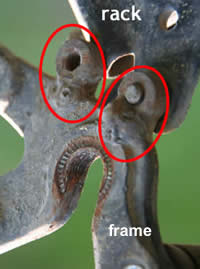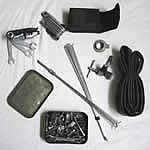Questions and answers about the foremost discussed topics on internet cycle touring forums. Our answers.
Q:
Steel vs. aluminium
A:
This is a topic that creates a lot of discussion in the cycling world. What bicycle to pick, steel or aluminium (or aluminum for those Americans among you :-). For us it wasn't so much of a choice, we just took our old, trusty, steel bikes. Why? Isn't steel a lot heavier than aluminium? Yes, steel might way in a little bit more, but the advantages outweigh the extra weight, as far as we are concerned. Steel for one is stronger, more flexible and can be welded everywhere in the world, if something should break. Here the aluminium cyclists step in by saying: "but do you want to let that guy on the street corner in Baluchistan weld your bike back together?" My answer is yes. First, because assuming the guy on that Baluchistan corner doesn't know what he's doing, is kind of short-sighted... secondly, assuming the worst (breaking your whole bike in half) is something 'aluminium cyclists' like to do... We have had our eyelets broken five times now. The eyelets that are attached to the frame to hold the luggage racks, that is. We had no problem finding a welder in Lisbon (Portugal), Sary Tash (Kyrgyzstan), Gyeongju (South Korea), San Blas (Mexico) and Dangriga (Belize). Third, what do you do when your aluminium bike has a breakdown? Throw it in the bin and buy a new one? Send it back home to have it welded by a 'professional'? You wouldn't use that guy on the street corner would you, even if he could weld aluminium...
To finalise this: When you have a brand new high end aluminium bike and you want to go on a year's trip, you'll probably be alright. For longer multi-year trips, I would choose steel over aluminium.
Q:
Rohloff vs. derailler
A:
Another big topic, especially on Dutch forums... Why not use a Rohloff hub? First let me say I don't have a Rohloff hub, have never ridden on a bike with one and, to make a long story short, will not buy one either... Why? If you look at it from a financial point of view: they cost an arm and a leg and you will never get your money's worth!
One Rohloff hub will set you back around € 1,000. That's the equivalent of 25 new Shimano cassettes and a few deraillers (OK, I am not a luxury junky, so I don't need the high end Shimano stuff). I am cycling at 20,000 kilometres per cassette (and chain), have changed one derailler in 14 years, which means you would have to cycle about 500,000 kilometres (!) with your Rohloff hub to break even with my cassette changing system. Even a Rohloff hub doesn't last that long (between 60,000 and 100,000 km?) So why do people buy them? Pros are the ease of changing gears, it is very supple and you can change gears even if you are standing still. I don't know how many times that may happen in your life, but for me that is not an argument to buy a toy worth € 1,000. Another con is the weight of the hub and the impossibility to repair it while on the road (you have to send it back to Germany to have it repaired / replaced). And not to forget the use of a completely different spoke size, also not very handy while on a long trip. Rohloff devotees say your derailler can bend while in transit on trains, buses etc. (bend it back!) and that you don't really have to look after your Rohloff except put some new oil in every 5,000 kilometres. I can tell you, that's all I do with my cassette... and my last crank / cassette / chain-set took me from Tehran (Iran) to San Christóbal (Mexico). That's an astonishing 22,369 kilometres and 740 metres. I rest my case.
Q:
Schwalbes or what?
A:
everybody uses them, everybody swears by them: Schwalbe tyres. You can't meet another longterm cycle tourer, or they are rolling along on this trustworthy German brand. But is it all a myth?
Sure, Schwalbe produces strong, sturdy and longlasting tyres with Kevlar inside, so you don't get a lot of punctures. But for this you have to pay (and for the name of course, as with every other big name brand). A standard Schwalbe tyre cost at least € 25, excluding air... If you go into the XR range, you pay double that. We have had a few punctures with Schwalbe Marathons, so they are not bullet-proof. Oh, and they are quite on the heavy side as well. So, is it worth forking out this amount of money for a tyre? A standard Schwalbe tyre should last at least 10,000 kilometres. At that stage the cost per 1,000 kilometres will be € 2,50. During our trip we have used quite a few brands, but Schwalbe didn't come out top. But who did? Well, first we rode the Karakorum Highway on Giant tyres. We did get a few more punctures, they don't use Kevlar, but the Giants lasted almost as long as the Schwalbes. The difference was, we could almost buy four (4) Giants for the price of one Schwalbe! Cost per 1,000 kilometres just under € 1. Then we discovered Cheng Shin Tyres (CST). They are as solid as anything, again a few more punctures than the Schwalbe, but nothing dramatic, and Sonya has ridden on two for amost 10,000 kilometres; at a cost of only € 0.50 per 1,000 kilometres. That is 5 times better than the cheapest Schwalbe tyre. Is that a mythbuster or what? Check out our tyre-comparison-chart on the cycling-equipment page.
Q:
Find vs. send
A:
when I needed a new 7-speed cassette in San Christóbal, Mexico, I searched hard and long to find one. Although there are quite a few, pretty good bike shops in town, they didn't have a 7-speed (too old!). I posted a message on a forum, trying to find out how I could transform an 8-speed into a 7-speed, but the first answer I got was somebody suggesting I'd have a 7-speed cassette sent over from the Netherlands. That would be a lot easier...
But I don't think that is what cycle touring is all about. Instead of buying a cassette in the Netherlands and having it sent over by courier at the cost of € 100, I decided to go back to the local bike shop and explain how to disassemble an 8-speed and transform it into a 7-speed. All in all, it took an hour; in the meantime I had a nice, though simple conversation with Paco, the mechanic (my Spanish isn't that good), who did a fantastic job on taking my cassettes apart and putting one of them back together. I supported the local economy by having it done there and saved € 99 in doing so. For us the motto is: think global, buy local.
Q:
7 / 8 or 9 speed
A:
Since I'm not going to buy a Rohloff, we can stick to the deraillers a bit longer. So what would you take on a long, long trip: a 7, an 8 or a 9-speed cassette? We had a bit of a problem to find a 7-speed in Chiapas, Mexico; they didn't stock parts that old, but I understand that in the western world the 7-speed is making a comeback. Due to its strength and durability compared to the 8,9 and 10 speeds. The higer the amount of gears, the smaller the cassette rings, the thinner the chain, the shorter the life span. I would probably put an 8-speed on next time, because of the availability.
Q: Travelling cyclist vs. cycling traveller; what's the difference?
A: as you probably figured out from the answers above, we are not bicycle fanatics... That may sound strange, coming from people that have cycled around the globe for five years running. But the truth is, we are travelling by bicycle because we like travelling, not because we like cycling. But because travelling by bicycle gives you that much more freedom compared to other forms of transport, we have chosen to travel by bicycle. We have also met plenty of people that love cycling and use their travels as a means to cycle, but normally we don't hang out with these people too long. We don't have much in common... ;-)
